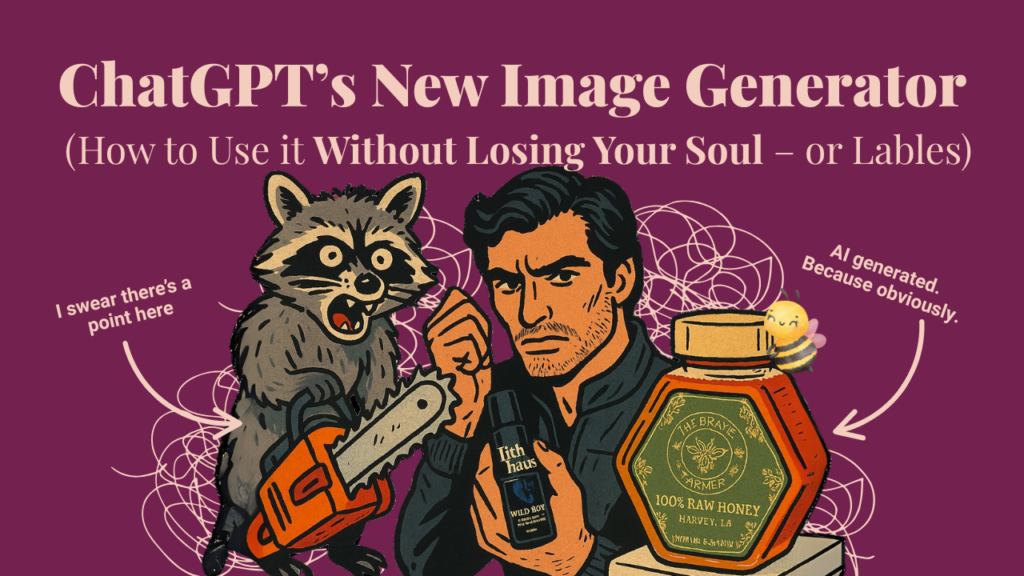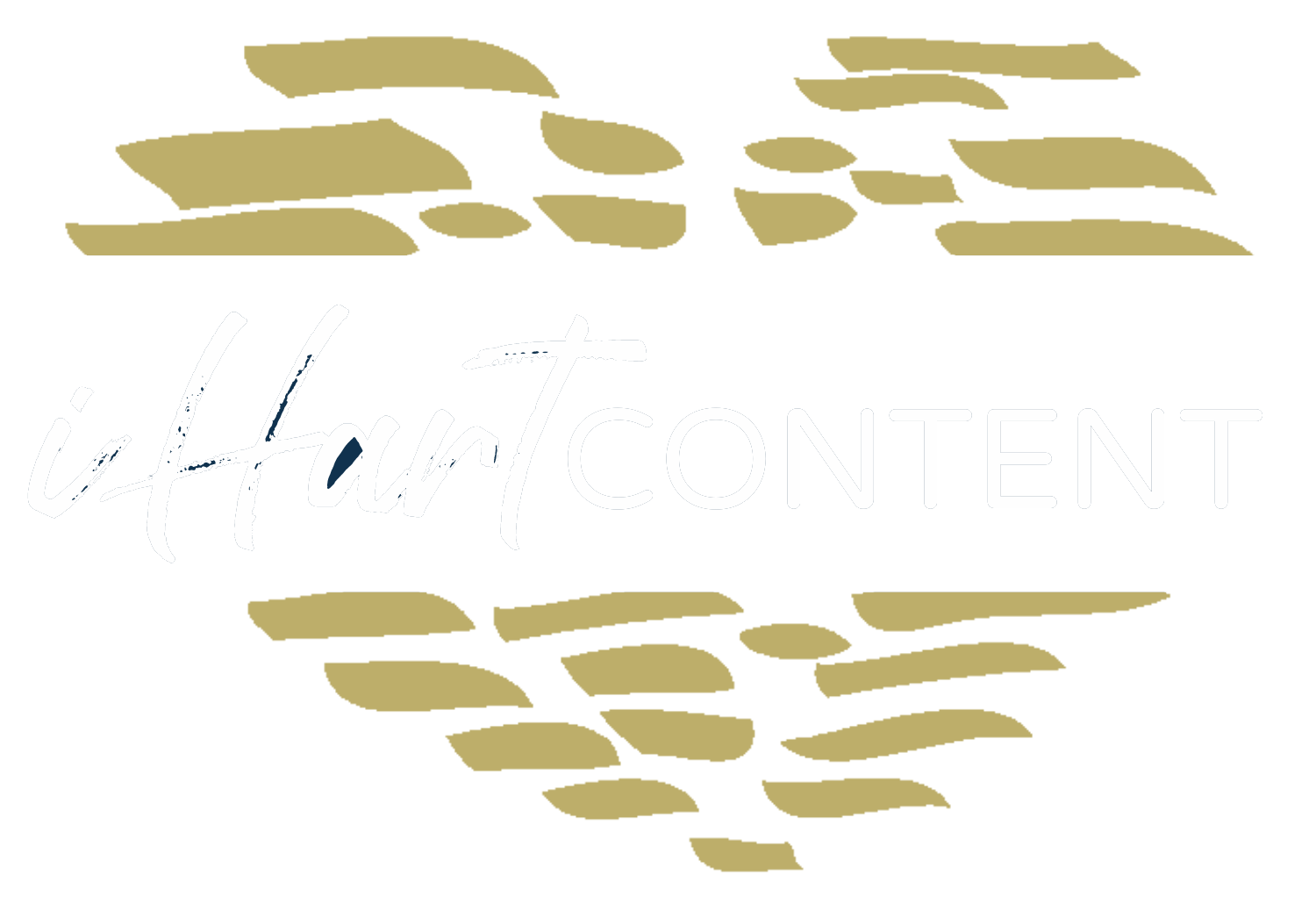Picture this: you click on a new website, and the very first thing you see is a gigantic logo splashed across half the screen. It’s beautiful, sure – but you still have no idea what the brand actually does or why you should care.
This is such a common home page trap, and I see it everywhere: leading with flashy branding instead of the transformation you offer your clients.
That right there? That’s the overlooked element so many businesses miss. Instead of helping visitors feel seen and relieved that they’ve found their solution, these sites basically shout “HERE’S OUR NAME!” with all the subtlety of a disco ball in a library. Maybe there’s a wall of awards or an endless list of services underneath, but none of that answers your visitor’s real question: “What’s in it for me?”
The truth is, the best reaction you can spark in those first few seconds isn’t “wow, nice logo.” It’s that moment of recognition – that instant “Hey, that’s me!” feeling that makes someone lean in closer to their screen. You want people to feel not just impressed by your brand, but genuinely understood. When your headline and visuals show them “Yes, you belong here and help is on the way,” they’ll keep scrolling every time.
In this blog, we’re looking at the biggest missteps that sabotage home pages – those simple, fixable mistakes that can turn a visitor off before they even read your first sentence. Whether it’s bland copy that says nothing about who you are or a layout so cluttered it buries your real message, we’ll walk through each pitfall and give you the pro-level tweaks to turn things around.
Problem #1: Generic, Unrelatable Images

You know what makes me do a double-take? Landing on a website for an accounting software company and being greeted by… a stock photo of someone walking on the beach at sunset. I mean, unless you’re promising your software will get me to retirement faster, what’s happening here?
When visitors don’t see themselves – or any clear connection to what you actually do – they start scrolling with that uncomfortable “Am I even in the right place?” feeling. Not exactly the vibe we’re going for.
Why It’s a Problem
Look, I get it. Finding the perfect website images can feel overwhelming, and stock photos are right there waiting for us. But here’s what happens when we get it wrong:
- Instant Disconnect: When your images are clearly staged or show people who look nothing like your target audience, you’re creating distance instead of rapport. (Nobody believes your tech startup is staffed entirely by models laughing at salads.)
- Wasted Opportunity: Your home page images are prime real estate. If they’re not reinforcing the transformation or benefit you offer, you’re missing a chance to captivate potential clients right from the start.
How to Fix It
- Choose Relevant Imagery: Don’t just pick pretty pictures (I know they’re tempting). Make sure they actually resonate with your brand’s mission or the outcome you promise.
- Reflect Your Audience: Show people or environments that match who you want to serve – or where they want to be. If you’re helping burnt-out entrepreneurs find work-life balance, maybe skip the “hustle harder” imagery.
- Tie It to Your Message: Sure, that serene beach photo might work – if you’re promising a stress-free lifestyle. Otherwise, stick with visuals that clearly illustrate your value.
- Make the Most of Stock: Working with a tight budget? No shame in that game. Find stock images that fit your vibe, then customize them to align with your brand colors or style. A little editing can go a long way in making them feel intentional rather than random.
Quick Win: Take a good look at that hero image on your home page. Ask yourself: “Does this actually speak to my audience and the result they’re after?” If your answer includes the word “kinda” or comes with a shoulder shrug, it’s time for a switch. Find something that makes your visitors stop and think “Yes, that’s exactly what I’m looking for!” right away.
Problem #2: Focus on Your Brand Name Instead of the Transformation

Let’s talk about something I see all the time: you land on a website, and the biggest text above the fold is just… the company name. Maybe with a tagline that lists their services. yawn
The problem? Your visitors still have no idea what’s in it for them. By the time they dig through your site trying to find the actual benefit or transformation you offer, they’ve either rage-scrolled past everything important or clicked away entirely. (And honestly, who can blame them?)
Why It’s a Problem
- Instant Confusion: Real talk – people aren’t visiting your site just to learn your name. They’re there because they have a problem that needs solving, like yesterday.
- Missed Emotional Connection: When you lead with brand-first messaging, you’re missing that crucial “Finally! Someone who gets what I’m dealing with!” moment that makes visitors stick around.
How to Fix It
- Uncover the Transformation: Start by asking yourself, “What’s the outcome my audience is lying awake at night dreaming about?” Maybe it’s freedom from that constant marketing overwhelm, a serious jump in sales, or simply feeling like they actually know what they’re doing in their business.
- Craft a Benefit-Focused Headline: Put that transformation front and center. For example, if you help entrepreneurs get their time back, don’t just say “Business Systems Consultant.” Try something like: “Gain Back 10 Hours a Week with Our Streamlined Systems—No Tech Wizard Status Required.”
- Subtle Brand Mentions: Your name and impressive awards list? They’re supporting characters, not the star of the show. Tuck them into a small logo in the header or a subtle “As Seen In” section further down.
- Celebrate Real Results: When possible, drop in a quick client win that shows exactly what kind of transformation you deliver. Nothing speaks louder than actual results.
Quick Win: Look at your hero text right now. If it starts with “Welcome to” or is just your company name, it’s time for a refresh. Replace it with a clear statement about what your audience actually gets from working with you. No fancy wordsmithing required – just tell them exactly how their life or business will be better after they work with you. They’ll feel seen, understood, and way more likely to stick around and learn more.
Problem #3: Bland Copy That Lacks Authentic Brand Voice

We need to talk about your website copy reading like a corporate PowerPoint presentation. You know the type – loaded with fancy jargon, light on personality, and about as engaging as watching paint dry.
Sure, it might sound “professional,” but does it sound like you? Because when visitors feel like they’re reading a textbook instead of hearing from a real person, they’re not just bored – they’re halfway out the digital door.
Why It’s a Problem
- Immediate Disengagement: When your copy sounds like a robot trying to impress a dictionary, your audience checks out faster than you can say “synergistic solutions.” (Please don’t ever say “synergistic solutions.”)
- Lost Opportunity for Connection: Here’s the truth – people buy from people. If they can’t feel any human warmth in your words, they’ll struggle to trust you or get excited about what you offer. And trust me, excited clients are the best clients.
How to Fix It
- Embrace Everyday Language: Write like you’re chatting with a friend over coffee (or wine, no judgment here). If you absolutely must use industry terms, keep them minimal and always explain them in plain English.
- Kill the Jargon: Seriously, let’s put phrases like “scalable methodologies” and “paradigm shift” and for the love of all things holy “move the needle” (a personal pet peeve!) out of their misery. Replace them with clear, benefit-focused wording that actually means something to your audience.
- Find Your Unique Voice: Are you naturally playful? Let it shine through! More direct and no-nonsense? Own it. The key isn’t trying to sound like everyone else – it’s consistently sounding like you.
- Ask for Outside Input: Have a friend or colleague read your web copy and ask them one simple question: “Does this sound like me?” If they hesitate or say “well, it’s very professional,” that’s code for “this sounds nothing like you.” Time for a rewrite.
Quick Win: Pull up your homepage text and highlight any words you wouldn’t actually use in conversation. (You know, those fancy-pants terms you think make you sound more legit.) Rewrite those sentences the way you’d explain them to a friend. Your readers should walk away thinking “Wow, I feel like I just had coffee with them,” not “I need to Google half these words.”
Problem #4: Poor Visual Hierarchy

Ever play that game where your eyes bounce around a website like they’re in a pinball machine? You’re trying to figure out what’s important, but everything’s screaming for attention at once. The main offer? Lost somewhere between three different “essential” buttons. The headline? Competing with a random testimonial slider that won’t stop moving.
When visitors can’t immediately latch onto your key message, they don’t just get confused – they get gone. Fast. This chaos usually starts with poor visual hierarchy: there’s no clear path guiding people from your biggest promise to that “heck yes, I need this” moment.
Why It’s a Problem
- Instant Overwhelm: When everything on your page is fighting for attention – huge text here, flashy image there, random pop-up everywhere – your visitors feel like they’re trying to follow a conversation in a crowded restaurant. With everyone shouting.
- Lost Clarity: Your homepage should spotlight the transformation you offer like a beacon in the night. But when your layout is cluttered, that message gets buried under a pile of “also important” elements that actually aren’t that important.
How to Fix It
- Establish a Focal Point: Pick the ONE thing you want visitors to notice first – usually your hero headline or main CTA. Make it impossible to miss, like that one friend who always shows up to brunch in hot pink (we all have one).
- Use White Space Wisely: Don’t try to cram every brilliant idea into the top section. Give your most critical elements room to breathe – think of it as social distancing for your content.
- Layer Your Sections: Guide people through your story logically, from the big promise to the supporting details. Think of it like a really good Netflix series – each episode (or section) should make them want to keep going.
- Assess Your Images: Check if they’re helping tell your story or just hanging around looking pretty. If that hero image is stealing the spotlight from your headline, it might be time for a heart-to-heart about roles and boundaries.
Quick Win: Here’s a fun test – stand back from your screen (literally, go ahead and do it) and see what catches your eye first. If it’s not your main headline or CTA, time to rearrange. A clear visual hierarchy isn’t just about looking pretty – it’s about making sure your visitors don’t need a treasure map to find the good stuff.
Problem #5: Competing or Confusing Calls to Action

Raise your hand if you’ve ever landed on a homepage that felt like a very enthusiastic but slightly desperate party host. You know the type – “Join my newsletter! No wait, book a call! Actually, read my blog first! Oh, and don’t forget to watch this video!”
While I totally get wanting to show visitors every possible way to connect (hello, fellow recovering people-pleaser), this approach is the fastest way to give someone decision paralysis. And what do people do when they’re overwhelmed with choices? Usually nothing at all.
Why It’s a Problem
- Desperation Vibes: Loading up your homepage with CTAs is like asking someone to marry you on the first date. Even if you’re amazing, you’re probably going to scare them off.
- Scattered Focus: Your homepage should tell one clear, compelling story that leads to one obvious next step. When you’ve got buttons competing for attention, you’re basically telling visitors “I’m not sure what you should do next, so… maybe try everything?”
How to Fix It
- Pick One Primary CTA: Decide the single most important action you want your audience to take. Maybe it’s booking that discovery call, snagging your lead magnet, or making a purchase. Make that button impossible to miss – like a neon sign in a dark room.
- Use Secondary CTAs Strategically: Need another action button? Fine, but make it visually subtle (think supporting actor, not trying to steal the show). An outline button or smaller text link can work wonders here.
- Time Your Offers: Not everything needs to be visible the second someone lands on your page. Reveal secondary CTAs as visitors scroll down, after they’ve had a chance to fall in love with your brand and understand exactly how you can help them.
- Stay On-Brand: Keep your button design consistent. Your primary CTA should pop with your signature color – make it something visitors learn to associate with “this is the good stuff right here.”
Quick Win: Take a hard look at what’s above the fold on your homepage. If you see more than one main CTA button screaming for attention, it’s time to pick a favorite. Give your audience one clear path forward, and they’ll be much more likely to actually take it.
Bringing It All Together: Your Home Page Makeover Checklist

Okay friend, we’ve covered the five biggest home page mistakes – from those generic stock photos to the “click ALL the buttons!” syndrome. But here’s what you really want to know: which fixes can you tackle over your lunch break, and which ones might need a bigger time investment?
Quick Fix vs. Full Redesign
- Minor Tweaks for Major Impact: Good news! If your issues line up with what we’ve talked about (like those vague headlines or the random beach photos), you can usually handle them without burning your whole site to the ground. A few smart content edits, a strategic image swap, or focusing your CTAs can transform your page faster than you can say “where’s my brand guide?”
- Time for a Larger Overhaul: Now, if you’re dealing with more technical issues – like a site that loads slower than dial-up internet, outdated tech that makes WordPress cry, or a developer who’s ghosted you – that’s when you might need to think bigger.
Your Top Quick Win: The Above-the-Fold Area
If you’re going to focus on just one spot (because let’s be real, you’ve got a business to run), make it the very first screen visitors see. This is where most home pages go wrong by trying to be everything to everyone. Instead:
- Speak to Your Visitor’s Pain or Desire: Let them see themselves in your words immediately. Think “Oh thank goodness, someone finally gets it!”
- Highlight THE Transformation: Be crystal clear about how working with you makes their life or business better. No fancy jargon needed.
- Offer One Clear Next Step: Whether that’s “Book a Call” or “Watch the Demo,” make it obvious what they should do next.
Next Steps: Ready to Revamp?
If you’ve made it this far (high five!), hopefully you’re feeling less overwhelmed and more empowered about your homepage. The best part? You don’t need to completely overhaul your site or max out your credit card on a massive redesign.
Sometimes, all it takes is refreshing that crucial first impression so your visitors instantly recognize their own story in your message – and see an obvious path forward.
But hey, if you’re looking at your schedule right now and thinking “I barely have time to grab lunch, let alone revamp my website,” I get it. That’s exactly why we created our Single Page Website Makeover service. It’s a focused, budget-friendly way to transform your most important page without the stress of a full site redesign.
The Bottom Line
Remember what we talked about at the start? Your home page isn’t meant to be a monument to your brand – it’s your chance to make someone feel seen, understood, and excited about working with you. By fixing these common issues (goodbye, generic stock photos and confusing CTAs!), you’re shifting the focus from “look how awesome we are” to “we totally get what you need.”
Whether you tackle these changes yourself or bring in some help, keep asking yourself: “How can I make my visitors feel instantly understood and confident they’re in the right place?” Nail that, and you’ll turn those casual browsers into eager subscribers and clients.







